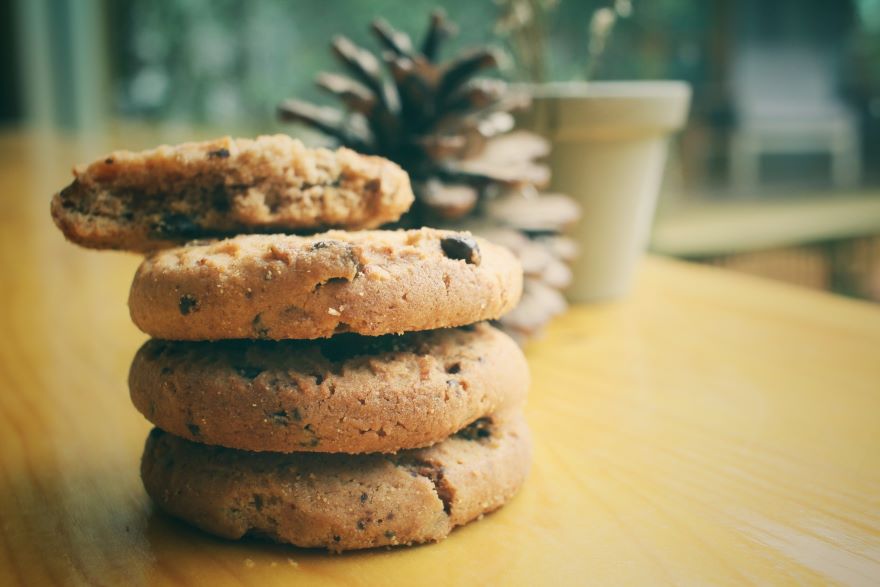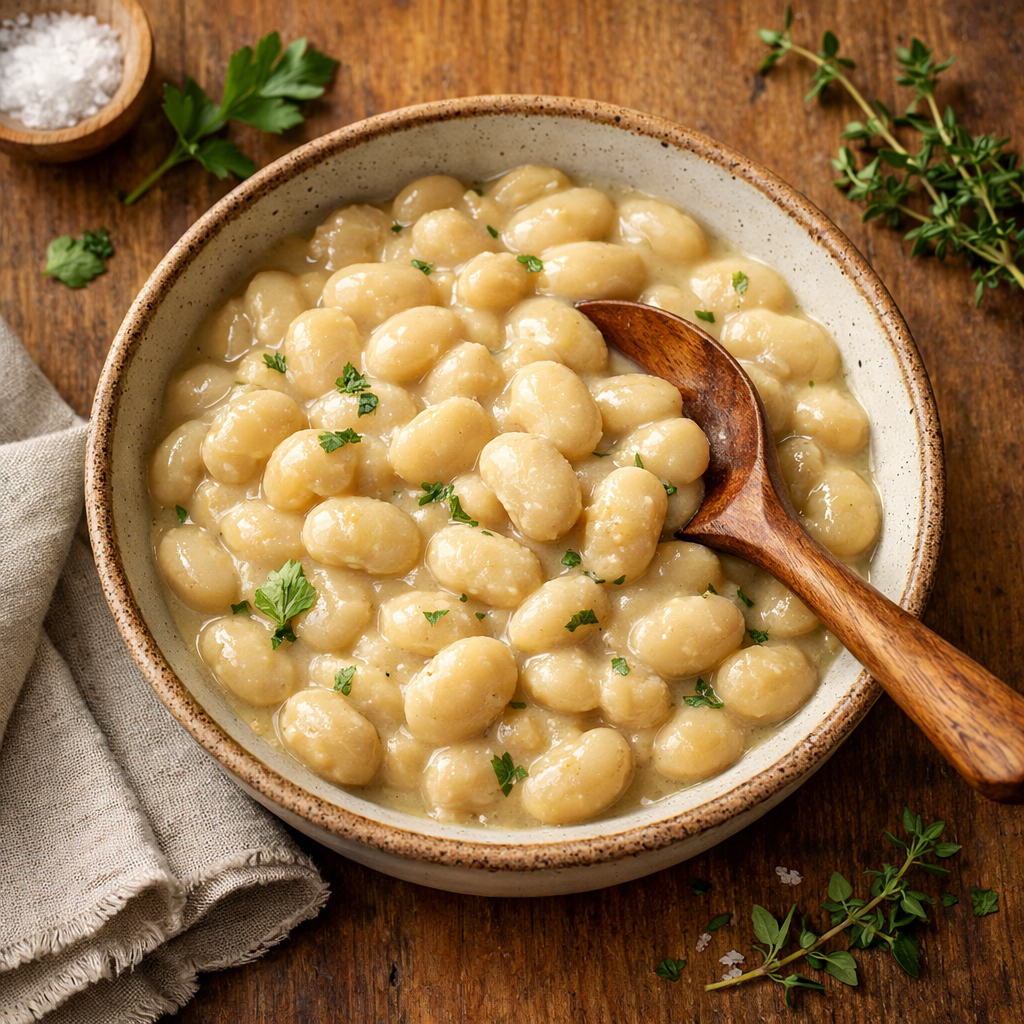If you’ve read any of my previous articles, you already know we’ve got a serious sweet tooth in this house—the cookie jar is never full for long! For the longest time, I thought great cookies had to include milk and butter to taste rich and satisfying. But that idea has definitely changed.
Lately, dairy-free cookies have become more than just a solution for allergies or sensitivities—they’ve turned into a go-to treat for anyone who wants something delicious, plant-based, and a little kinder to their body and the planet. What surprises most people is just how good they are—sometimes even better than the traditional ones.

Baking without dairy isn’t just about substitutions. It opens up a world of creative ingredients and fun flavor twists that make cookie-making feel fresh and exciting again. So, if you’re curious, ready to experiment, or just craving something sweet, this guide has everything you need to start whisking up your own irresistible vegan treats.
My Health and Wellness Coaching Insights
Last week, my coaching course gave me a deeper understanding of how poor nutrition affects health, wealth, and social opportunity. This article about dairy-free cookies may sound mediocre at first glance, but the learnings I’m going to share are invaluable.
The course highlighted how food sensitivities and allergies can significantly impact quality of life, and how making informed dietary choices—even in treats like cookies—can contribute to overall wellness. With more people discovering dairy sensitivities or choosing plant-based diets for ethical and environmental reasons, having delicious alternatives becomes important for inclusivity and enjoyment.
The Personal Benefits I’ve Found Going Dairy-Free
Eliminating dairy from everyday recipes can bring surprising benefits. In some households, family members who once avoided desserts due to mild digestive issues now enjoy sweet treats without discomfort. While reactions to dairy vary, offering alternatives allows everyone to take part in dessert time.
Choosing dairy-free cookies and other plant-based desserts also aligns with a more environmentally conscious lifestyle. Dairy production is known to have a significant environmental footprint, including high water usage and greenhouse gas emissions. Each batch of cookies made with plant-based ingredients becomes a small but meaningful step toward sustainability.
For parents of children with dairy allergies, these recipes can be a game changer. There’s something truly special about seeing a child light up when they realize they can enjoy cookies just like everyone else. With accessible ingredients like almond milk, coconut oil, and plant-based butter, whipping up delicious dairy-free cookies is within reach for home bakers everywhere.
The Difference Between Dairy-Free and Vegan Cookies
Dairy-free cookies exclude all milk-derived ingredients such as butter, milk, cream, whey, and some types of chocolate. However, dairy-free recipes may still include eggs, which, while not dairy, are still animal-derived.
Vegan cookies, on the other hand, go a step further by eliminating all animal products. This includes not only dairy and eggs but also ingredients like honey and certain refined sugars processed with bone char. For anyone baking for friends or family with various dietary preferences or restrictions, understanding the difference between dairy-free and vegan is key to meeting everyone’s needs.
Essential Ingredients in My Vegan Cookie Pantry
Over the years, I’ve assembled a reliable collection of ingredients that form the foundation of my dairy-free cookie recipes:
- Vegan Butter: My go-to substitute for traditional butter, typically made from plant oils.
- Coconut Oil: I love this for cookies requiring a rich, buttery texture. It’s solid at room temperature, making it perfect for no butter cookies that still maintain that classic mouthfeel.
- Almond Milk: The most versatile plant milk for my baking needs, though oat milk works beautifully too.
- Flaxseed Egg: When creating egg-free cookie recipes, I mix ground flaxseed with water to create a gelatinous mixture that binds ingredients together just like eggs would.
- Dairy-Free Chocolate Chips: These contain cocoa butter (which, despite the name, is plant-based) but no milk solids.
Ready-to-Enjoy Option: For those days when you want a treat without baking, Enjoy Life Soft Baked Double Chocolate Brownie Cookies deliver rich, fudgy goodness that’s certified gluten-free, vegan, and allergy-friendly. Perfect for those avoiding dairy, nuts, and soy, these soft and chewy cookies use high-quality, non-GMO ingredients for a decadent chocolate flavor.
- Bulk cookies contain (6) boxes (6 oz each) with 12 Enjoy Life Soft Baked Double Chocolate Brownie Cookies
- Dairy free cookies made in a dedicated nut-free and gluten-free facility and safe for schools
- Chocolate cookies made with high-quality, pure, dairy-free chocolate chips and vanilla extract for handcrafted flavor
- Non-GMO Project Verified and certified gluten free cookies are also vegan, kosher and halal for a worry-free snack that’s safe enough to share, but good enough not to
- All Enjoy Life products are certified gluten free, and are also wheat free, peanut free, tree nut free, dairy free, casein free, soy free, egg free, sesame free, mustard free, lupin free, added sulfites free, fish free, shellfish free, and crustacean free
Cookie Varieties That Redefined My Baking Style
Classic Favorites Reimagined
The first dairy-free cookie that truly convinced me I wasn’t missing out was my vegan chocolate chip cookie. Using a combination of coconut oil, a flaxseed egg, and high-quality dairy-free chocolate chips, I created a chewy, rich cookie with the perfect crisp edge that even my dairy-loving friends couldn’t resist.
My oatmeal cookies have evolved to include maple syrup sweetened variations that add a depth of flavor traditional recipes often lack. The natural sweetness of maple syrup complements the earthiness of oats perfectly, creating a harmonious balance that’s become my signature.
For the holidays, I’ve developed vegan holiday cookies that have become a tradition in my household. My gingerbread people, decorated with dairy-free royal icing (using aquafaba instead of egg whites), bring the same festive joy without the dairy.
Exploring Beyond the Classics
Venturing beyond the classics led me to discover coconut oil cookies that showcase tropical flavors. By incorporating shredded coconut and a hint of lime zest, I created a cookie that transports me to a beach vacation with every bite.
My almond milk cookies featuring almond flour create a tender, slightly chewy texture that’s become a favorite for afternoon tea. The subtle nuttiness pairs beautifully with a cup of Earl Grey, creating a sophisticated treat that’s miles away from the image of “alternative” baking many people hold.
Perhaps my proudest achievement is my vegan peanut butter cookies. By carefully balancing natural peanut butter with the right sweeteners and binders, I’ve created a cookie that’s simultaneously rich, chewy, and perfectly sweet without any dairy or eggs whatsoever.
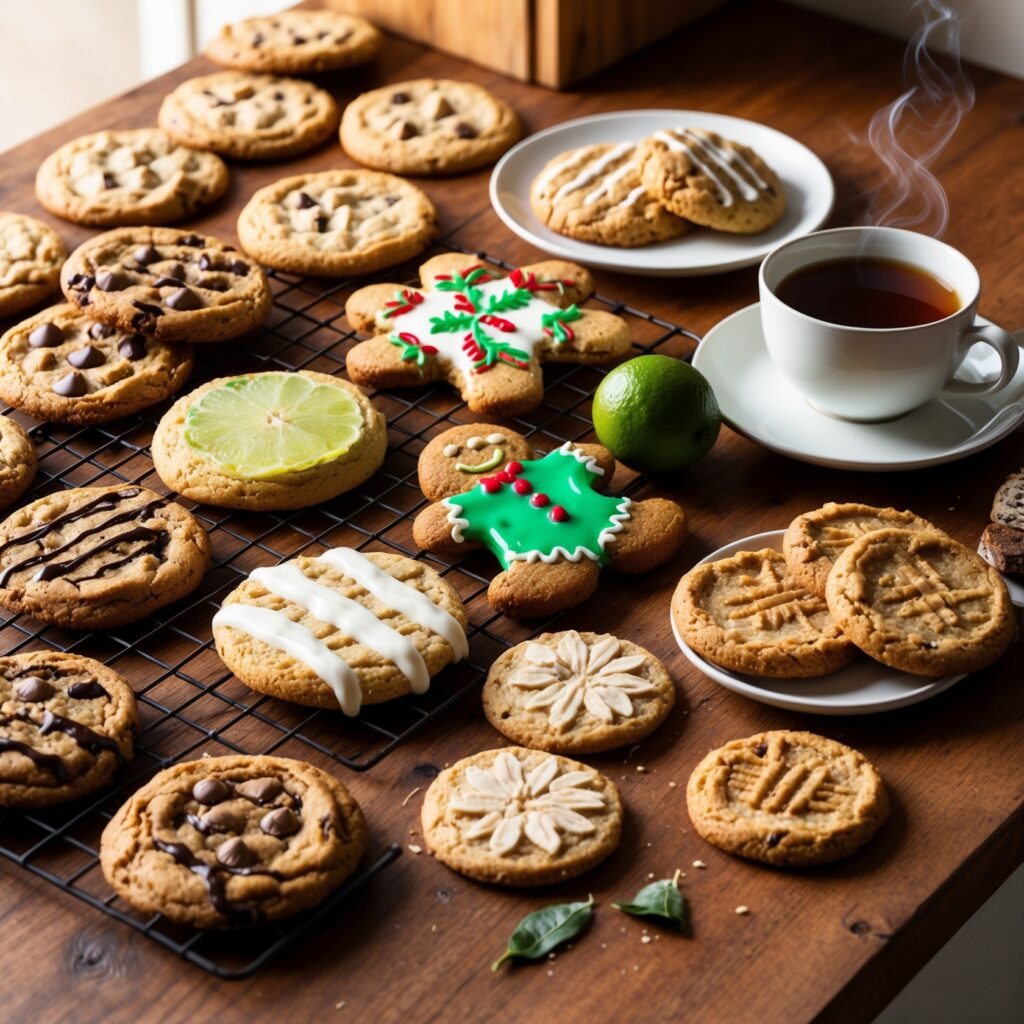
Enticing Kid-Friendly Plant-Based Cookies
My 3 kids are all grown up now, but when they were younger, making enticing food was quite a challenge. They were all picky eaters and my creativity was tested daily. These simple yet effective approaches transformed plant-based baking from a potential battleground to a joyful experience for the whole family.
Making Irresistible Treats for Little Ones
Children eat with their eyes first, so I focused on visual appeal. My plant-based chocolate chip cookies used extra chocolate chips, creating that irresistible speckled look kids crave. For special occasions, natural food coloring from fruits and vegetables created vibrant sugar cookies even my pickiest eater couldn’t resist.
Texture matters immensely to children. The perfect combination of vegan butter and coconut oil creates cookies with the ideal chew—not too soft, not too crispy. This familiar texture made the transition to plant-based seamless, winning over my toughest critics.
Fun Shapes and Decorations
Cookie cutters became my secret weapon. Star, heart, and animal-shaped vegan cookies distracted from any subtle flavor differences. I decorated them with plant-based icing made from powdered sugar, almond milk, and natural coloring.
For birthdays and playdates, “sprinkle cookies” with vegan sprinkles atop almond milk cookies became legendary. These colorful treats were so popular I regularly fielded recipe requests from other parents desperate for their own picky-eater victories.
Getting Kids Involved in the Process
Perhaps the most effective way to get children excited about plant-based cookies is involving them in the baking process. My easy vegan cookies recipe featuring maple syrup sweetened dough is perfect for little helpers. The dough is forgiving, and children love measuring and pouring the maple syrup.
When children participate in creating their treats, they develop ownership and pride that translates to greater enjoyment. I’ve watched previously skeptical children become enthusiastic advocates for plant-based baking after helping to make a batch of coconut oil cookies decorated with their own artistic touches.
Techniques I Swear By
When mixing my dairy-free cookie dough, I follow this sequence religiously:
- Cream the fat (vegan butter or coconut oil) with sugars until light and fluffy
- Add liquid ingredients (vanilla, flaxseed eggs, almond milk)
- Gently fold in dry ingredients until just combined
- Fold in mix-ins (chocolate chips, nuts, etc.)
Avoid overmixing plant-based doughs to prevent tough cookies. Chill dough for at least two hours (preferably overnight) to enhance flavor and prevent spreading. Use an ice cream scoop for uniform cookies that bake evenly.
A food processor is a must-have in any vegan baker’s kitchen, and the Cuisinart Food Processor is one of the best on the market. It excels at chopping, slicing, and pureeing, making it perfect for preparing cookie doughs, grinding flaxseed for flax eggs, or even making nut butter. With its powerful motor and large capacity, it saves time and adds efficiency to your plant-based baking.

Cuisinart FP-130 13-Cup Multifunctional Food Processor White
- New motor platform enables this versatile food processing system to offer variety of functions, attachments and accessories
- Basic Accessories: Chopping Blade, Fine and Medium Reversible Slicing and Shredding Discs
- Control Paddles: High/Low/Pulse speeds
- 13-Cup Tritan work bowl comes with large, medium, and small pushers and includes a bowl lid with sea
My Favorite Healthy Plant-Based Cookie Recipes
After years of testing and refining, I’ve developed several dairy-free cookie recipes that are not only delicious but also packed with nutritious ingredients. These recipes focus on wholesome components while avoiding refined sugars when possible and incorporating nutrient-dense alternatives.
Nutrient-Packed Oatmeal Flaxseed Cookies
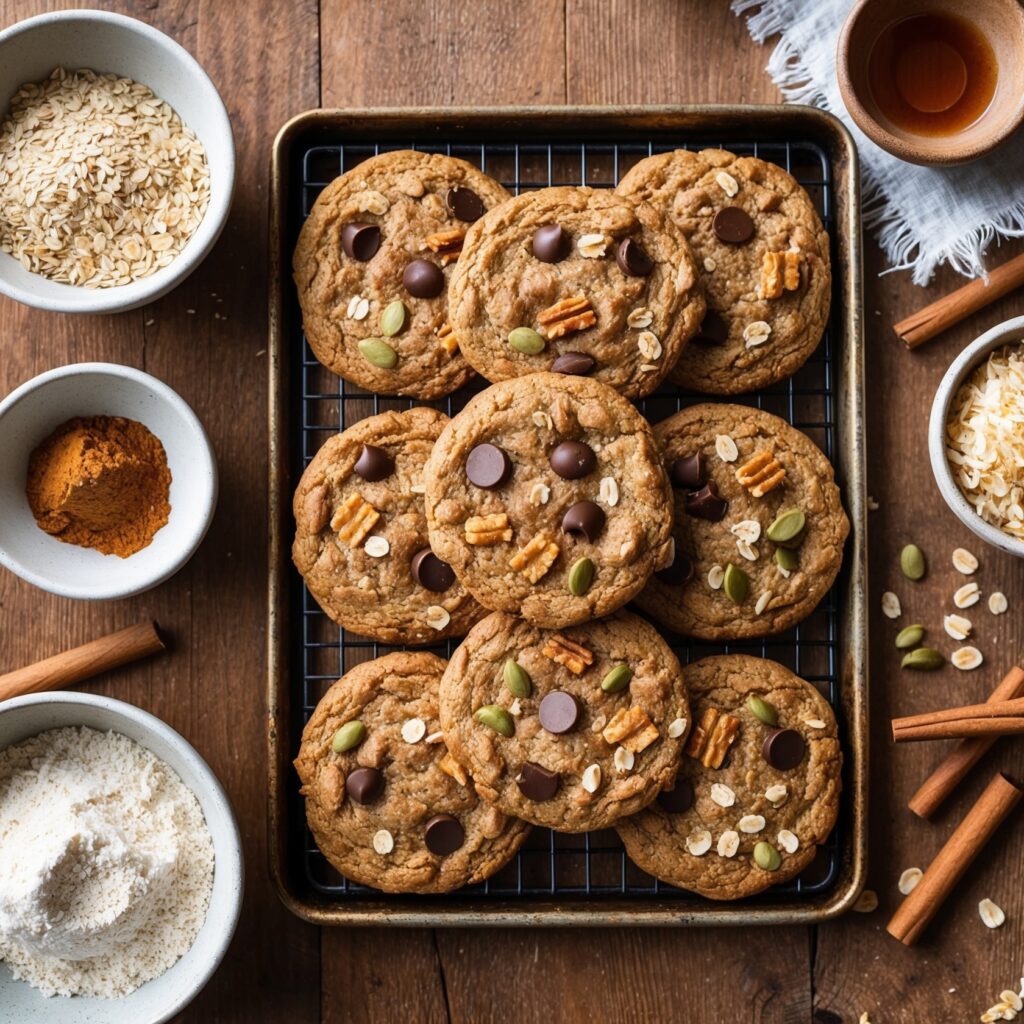
These hearty flaxseed egg cookies are full of fiber, omega-3 fatty acids, and complex carbohydrates, making them a satisfying treat that won’t spike blood sugar levels.
Ingredients:
- 2 tbsp ground flaxseed + 6 tbsp water (flaxseed eggs)
- 1/2 cup coconut oil, softened
- 1/3 cup pure maple syrup
- 1/4 cup coconut sugar
- 1 tsp vanilla extract
- 1 3/4 cups rolled oats
- 1 cup almond flour
- 1/2 cup unsweetened shredded coconut
- 1/2 tsp baking soda
- 1/4 tsp salt
- 1/2 tsp cinnamon
- 1/3 cup dairy-free dark chocolate chips
- 1/4 cup chopped walnuts
- 1/4 cup pumpkin seeds
Instructions:
Prepare flax eggs and let sit.
Preheat the oven to 350°F.
Mix wet ingredients, then add flax eggs.
In a separate bowl, combine dry ingredients.
Combine all, fold in add-ins, form dough balls, and bake for 12–14 minutes.
Almond Butter Superfood Cookies
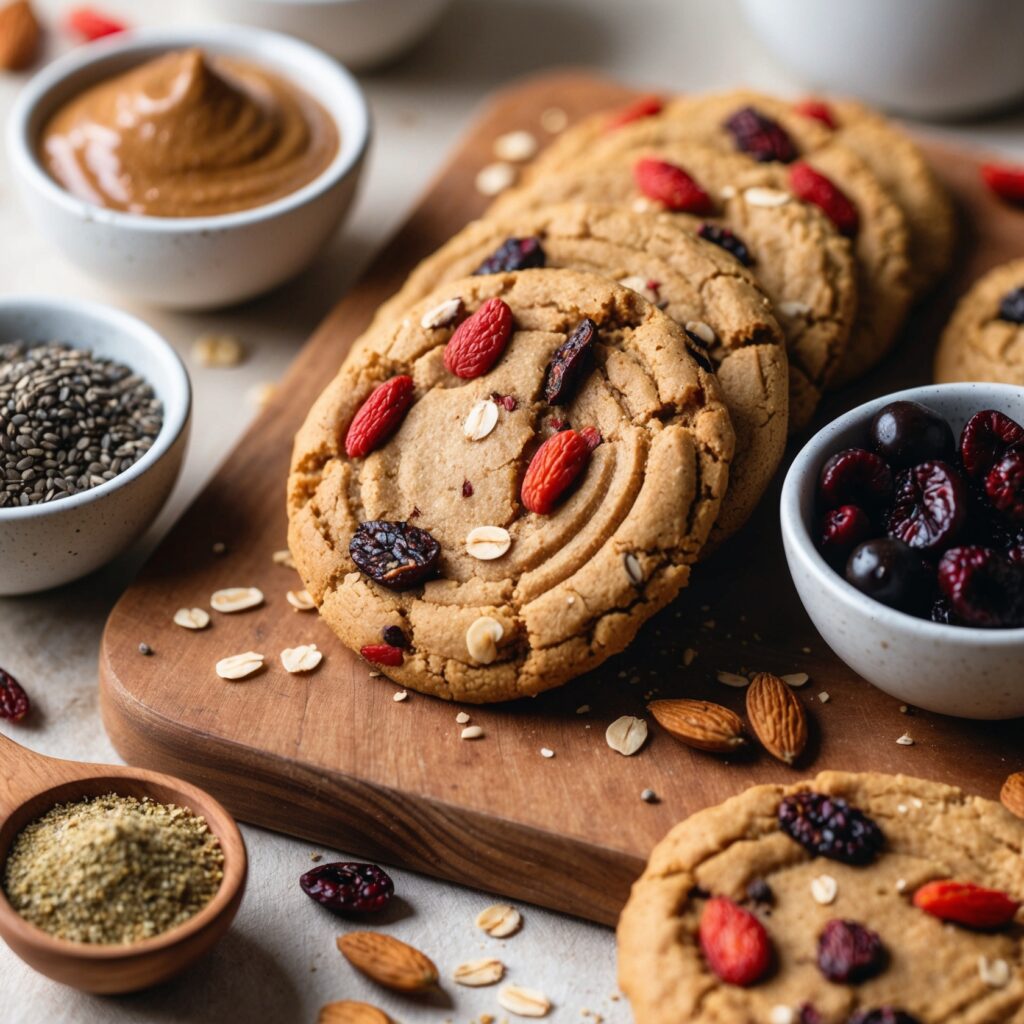
These protein-rich vegan cookies contain no refined sugar and are loaded with superfoods for an energizing treat.
Ingredients:
- 1 cup natural almond butter
- 1/3 cup maple syrup
- 1 tbsp chia seeds + 3 tbsp water
- 1 tsp vanilla
- 1/2 cup oat flour
- 1/2 tsp baking soda
- 1/4 tsp sea salt
- 2 tbsp hemp seeds
- 2 tbsp cacao nibs
- 1 tbsp maca powder (optional)
- 1/4 cup goji berries
- 1/4 cup chopped dried cherries
Instructions:
Make chia egg.
Preheat the oven to 325°F.
Mix wet ingredients, add dry, fold in superfoods, drop spoonfuls on tray, flatten
Bake for 10–12 minutes.
Sweet Potato Spice Cookies
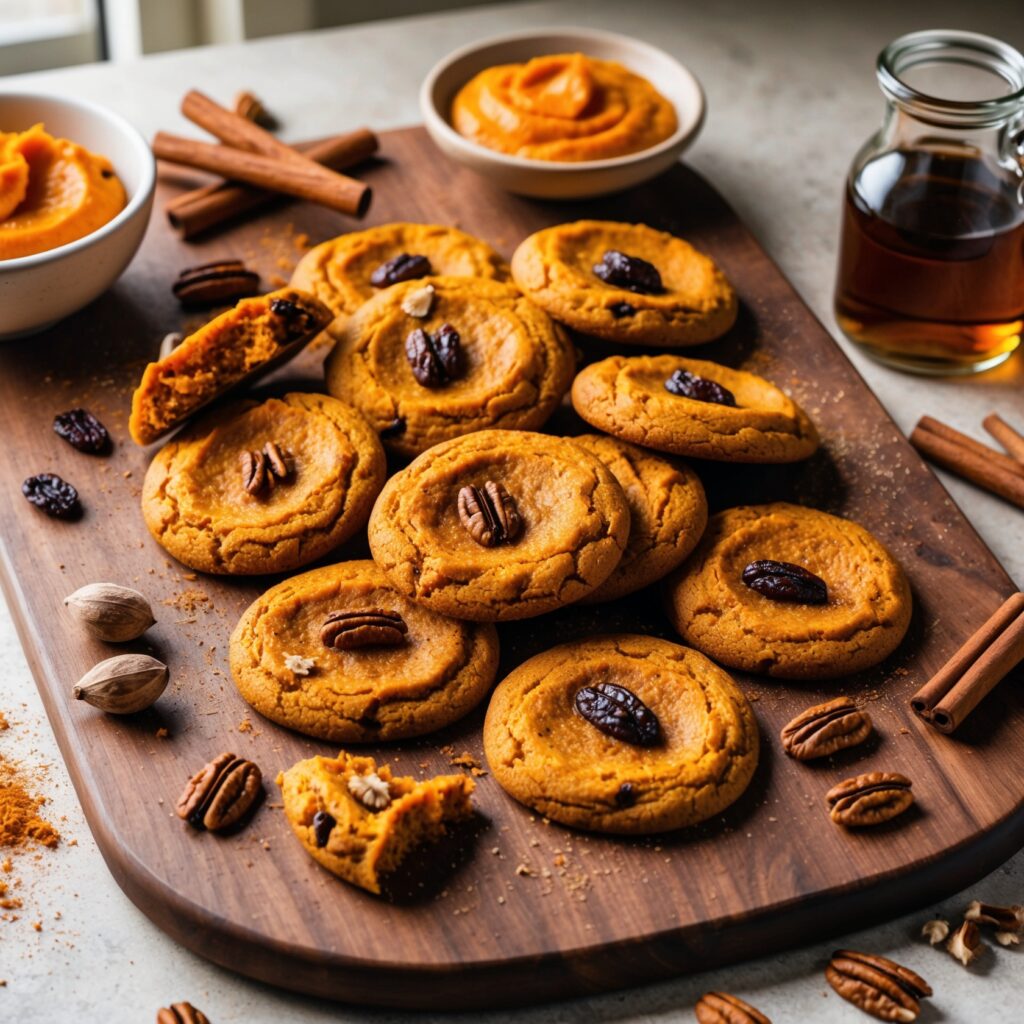
These innovative cookies incorporate vegetables for natural sweetness and moisture.
Ingredients:
- 1 cup sweet potato puree
- 1/4 cup melted coconut oil
- 1/4 cup maple syrup
- 1 tsp vanilla extract
- 2 cups almond flour
- 1/2 cup tapioca flour
- 2 tsp cinnamon
- 1/2 tsp ginger
- 1/4 tsp nutmeg
- 1/4 tsp cloves
- 1 tsp baking powder
- 1/2 tsp baking soda
- 1/4 tsp salt
- 1/3 cup chopped pecans
- 1/4 cup raisins or mulberries
Instructions:
Preheat the oven to 350°F.
Mix wet ingredients.
Combine dry ingredients in another bowl.
Mix both, fold in nuts and fruit, scoop and flatten dough,
Bake for 15–18 minutes.
Troubleshooting Common Baking Challenges
Even seasoned bakers hit bumps when working without butter or milk. Here are a few common issues and how I fix them:
When Cookies Spread Too Much:
- Chill the dough
- Add more brown sugar
- Use slightly more flour
- Make sure coconut oil isn’t too warm
If Cookies Turn Out Dry:

- Add 1 tbsp of applesauce or plant yogurt
- Reduce baking time
- Use brown sugar for more moisture
- Add a splash of plant milk
When Flavors Fall Flat:
- Add extra vanilla
- Use a pinch of salt
- Toast nuts before adding
- Try brown butter–flavored vegan butter
A Silpat Non-Stick Baking Mat is an excellent addition to any baker’s kitchen. This reusable mat provides a non-stick surface, preventing cookies from sticking to the baking sheet, while also ensuring even heat distribution for perfectly baked treats every time. It’s especially useful for making sure your dairy-free cookies bake without sticking or losing their shape, providing a hassle-free cleanup experience.

Silpat Premium Non-Stick Silicone Baking Mat, Half Sheet Size, 11-5/8 x 16-1/2, Orange
- Turn ANY pan into a non-stick surface and save time cleaning up! Use Silpat instead for any baking recipe (sweet or savory) that calls for parchment paper; Silpat replaces the need for butter, grease, oils, and sprays
- Made of fiberglass mesh and the highest quality food grade silicone, which provides consistent heat distribution and promotes even baking and browning
- Silpat is the original non-stick baking mat and has stood the test of time with use by the most demanding chefs in the world
- Mat measures 11-5/8″ x 16-1/2″; Made for a 13″ x 18″ pan
Easy Vegan Cookies for Beginners
If you’re new to dairy-free baking, start with these foolproof crowd-pleasers. Three-Ingredient Peanut Butter Cookies use just natural peanut butter, sugar, and a flax egg to create a simple yet satisfying treat. Simple Coconut Oil Chocolate Chip Cookies combine melted coconut oil and dairy-free chips for an easy, chewy, and reliable classic that everyone loves. One-Bowl Oatmeal Cookies offer endless customization options with nuts, dried fruit, or vegan chocolate chips, making them perfect for using whatever ingredients you have on hand.

What’s Next in My Cookie Evolution
I’m currently diving into new techniques to expand my dairy-free baking repertoire. Aquafaba for meringue-based cookies has been a revelation, producing light, crisp results I didn’t think possible without egg whites. My fermentation experiments with cultured plant-based butter alternatives are creating amazing depth of flavor in my sourdough discard cookies, opening up entirely new dimensions in vegan baking.
Final Thoughts
What began as my conscious choice to embrace a healthier lifestyle has blossomed into a passion that brings me daily joy every single day. Experimenting with plant-based cookie recipes satisfies the sweet tooth while connecting with a community of like-minded bakers and expanding culinary horizons in unexpected ways.
The world of vegan cookies and plant-based desserts is vast and constantly evolving. Each time I discover a new baking substitute or improve a challenging classic, I’m reminded that intentional choices often lead to the most creative solutions.
The reasons for choosing plant-based cookies—be it health benefits, ethical considerations, or simple curiosity—all lead to the same delicious possibilities worth exploring. I’ve found that what initially seemed like a limitation has become the doorway to a more expansive, flavorful world of baking.
So preheat the oven, gather those plant-based ingredients, and begin on this sweet adventure. Your perfect vegan cookie awaits.
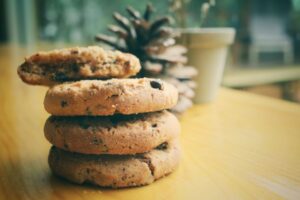
*We may earn a commission for purchases made using our links. Please see our disclosure to learn more.

